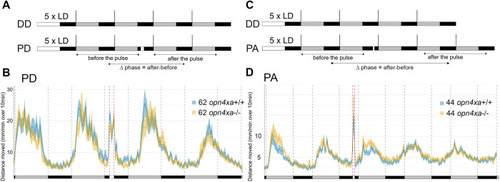|
Larvae devoid of opn4xa-mediated photosensitivity (opn4xa-/-) still photoentrain to pulses of light at CT16 and CT21. A) Experimental design of phase shift experiments. White rectangles represent the day or light pulse period, black rectangles represent the night period and dark grey rectangles represent the subjective day. For each experiment, larvae are entrained for 5 LD cycles the larvae are therefore 5dpf at the beginning of locomotor activity measurements. Locomotor activity is tracked either in constant darkness for 4 days (DD) or tracked in constant darkness for 4 days and subjected to a 2-hours pulse of light during the night of the 2nd day of constant darkness (PD). The phase of locomotor activity is calculated for each larva before and after the timing of the pulse for DD and PS experiments and the Δphase (phase after the pulse–phase before the pulse) is calculated. B) Average distance moved (mm/min over 10min) of 3 independent PD experiments. Mean ± SE. The Δphase of opn4xa+/+ and opn4xa-/- larvae calculated with the FFT-NLLS method is not significantly different. opn4xa+/+ and opn4xa-/-show similar levels of activity during the light pulse (p = 0.56, Mann-Whitney two-tailed test). C) Experimental design of phase advance (PA) experiments. The iconography is similar to A). PA-pulsed larvae were subjected to a one-hour pulse of light at CT21. D) Average distance moved (mm/min over 10min) of 3 independent PA experiments. Mean ± SE. The Δphase of opn4xa+/+ and opn4xa-/- larvae calculated with the FFT-NLLS method is not significantly different (Mann-Whitney two-tailed test).
|

